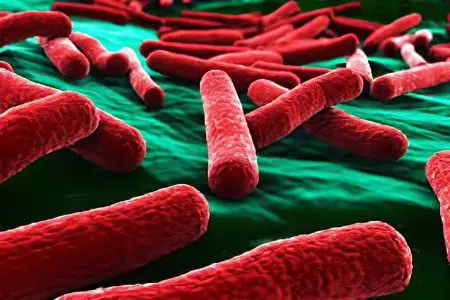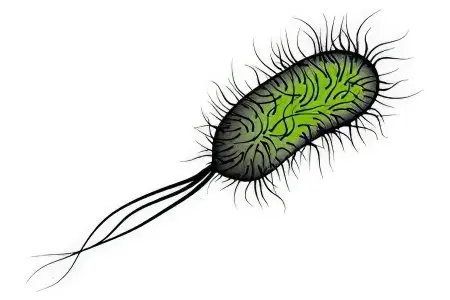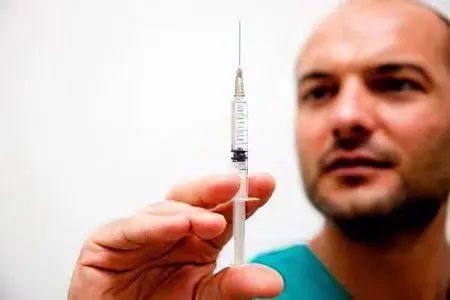Contents
What is typhoid fever?

Typhoid fever is an infectious disease from the group of anthroponoses with a fecal-oral transmission mechanism, caused by one of the varieties of Salmonella and proceeding with a predominant lesion of the lymphatic apparatus of the small intestine against the background of pronounced toxic manifestations.
Despite the fact that humanity in the last century has managed to significantly reduce the number of registered cases of typhoid fever, solved to the end, this problem cannot be called. The likelihood of developing the disease exists, especially in countries with a turbulent military situation and poor hygiene standards for life. Therefore, unsanitary conditions are the main condition for the spread of the disease.
Typhoid fever refers to diseases exclusively of the human population. Infection occurs after the release of pathogens into the environment with the feces of carriers and sick people. At the same time, they contaminate water, food, and household items. Not the least importance belongs to flies as external carriers of pathogens. A healthy person can become ill after eating contaminated food or after direct contact with a sick person.
In this regard, typhoid fever is characterized by the following features:
Predominant occurrence in the hot months and autumn;
Rapid spread with the transition to an epidemic;
The absolute susceptibility of the human body to the pathogen;
Rapid reproduction of salmonella with their massive release into the environment with each bowel movement;
The long course of the disease (about seven weeks) and the presence of its erased forms;
The presence of carriers of the pathogen. Such people do not get sick, but are contagious to others;
The pathogenesis of the disease and the spread of the pathogen in the body consists of several stages:
Entry of a sufficient concentration of pathogens into the terminal sections of the small intestine;
Introduction through the mucous membrane with the development of an inflammatory process in the form of enteritis;
Penetration into the lymphoid tissue, to which Salmonella has an initial tropism. First, Peyer’s patches are affected, and then the regional lymph nodes of the mesentery (mesenteric) and retroperitoneal;
Bacteremia (the entry of pathogens into the systemic circulation). This occurs due to the inability of the lymphatic system to retain and neutralize the pathogen. This is manifested in the form of their strong increase. Once in the blood of the portal system, the pathogen primarily spreads to the liver and spleen. In the cells of the reticuloendothelial system of these organs, its further reproduction occurs. As a result – inflammatory damage to the liver and spleen;
The circulation of the pathogen in the systemic circulation triggers immune responses. In this case, a massive destruction of pathogenic bacteria occurs, which, along with bacteremia, causes toxemia due to toxins that are released from the destroyed pathogens.
All these links of pathogenesis are cyclic in nature, constantly repeating until the immune mechanisms are strengthened enough to neutralize all pathogenic pathogens in the tissues of the lymph nodes, liver and spleen.
Symptoms of typhoid fever
The clinical picture of typhoid fever emerges from the above features of its pathogenesis and is given in the form of a table.
The incubation period | Its duration is from three days to three weeks. At this time, nonspecific symptoms are possible in the form of general weakness, weakness, poor health, nausea, headaches and muscle pain, mild subfebrile condition. |
Fever and temperature reactions | There is an increase in body temperature to hectic numbers. Such fever is noted periodically, which corresponds to a massive release of salmonella into the systemic circulation. |
Intoxication symptoms |
|
Signs of damage to the mesenteric lymph nodes and small intestine (mesadenitis on the background of enteritis) |
|
Signs of damage to the liver and spleen |
|
The dynamics of symptoms in typhoid fever allows you to combine them according to the stages of the disease:
Incubation period. It continues from the moment the pathogen enters the body until the first clinical manifestations appear. The duration of this period depends on the pathogenic properties of the pathogen and the body’s defenses;
The period of onset of the disease. Lasts several days. Clinical it can be limited by the appearance of the first temperature reaction to its stable maintenance at a high level;
Expanded flow period. It is characterized by all the symptoms of damage to internal organs and intoxication;
Permission period. Presented by a stepwise regression of symptoms and a decrease in fever;
convalescence period. It represents a complete restoration of the body and the formation of stable immunity.
Not always such a clear sequence of flow is observed. The disease can acquire an unpredictable character with a lightning-fast transition from one stage to another or their undulating change.
The danger of typhoid fever lies in the possibility of developing complications that pose a direct threat to the life of the patient. In the case of disease progression, there is a high risk of progressive liver failure, which, against the background of intoxication, can turn into multiple organ failure.
Local complications are no less dangerous. Their occurrence is associated with necrotic and ulcerative lesions of the terminal part of the small intestine. Against this background, profuse intestinal bleeding and perforation of the intestinal wall very often occur. These conditions require urgent surgical treatment. Carrying out any operation at the height of intoxication and organ failure always leads to aggravation of the general condition of patients with typhoid fever.
The causative agent of typhoid fever

The pathogen that causes typhoid fever is one of the Salmonella species, Salmonella typhi. It is a gram-negative bacillus from the family of enterobacteria, capable of reproducing exclusively in the human body. It has no morphological differences from other Salmonella. A strict aerobe, therefore, it can only exist in a living form, does not form spores. It is not demanding on environmental conditions and therefore it is well cultivated on ordinary nutrient media. This type of Salmonella is quite stable in the external environment, perfectly adapted to low temperatures and can survive even prolonged freezing.
Not resistant to high temperatures and instantly dies when boiled. It retains pathogenic properties well in running and stagnant water and food (dairy products, vegetables, minced meat).
The pathogenicity of typhoid Salmonella is due to their antigenic structure and endotoxin. The main ones are the surface virulence antigen (Vi antigen) and the cell wall liposaccharide protein complex (endotoxin). If the former determines the ability of the pathogen to infect organs and tissues, as well as the intensity of the immune response, then the latter is activated when Salmonella is destroyed by immune cells with a powerful release of their toxic components. The features of the virulence antigen of the causative agents of typhoid fever are such that they allow it to change its antigenic properties, passing into different forms, including L-forms that are resistant to the action of antibacterial drugs. This allows the pathogen to circulate for a long time, maintaining epidemic spread.
The life cycle of typhoid salmonella after entering a susceptible organism cannot pass without the participation of lymphoid and reticular tissues. Therefore, the entrance gate of the infection is the accumulation of intestinal lymphatic cells (Peyer’s patches) in the submucosal layer. Of these, the bacteria spread to the mesenteric lymph nodes and into the portal circulation. The most important breeding site for typhoid salmonella is the liver and spleen. Over time, immune mechanisms are able to neutralize pathogens completely, as specific antibodies are produced.
Serological testing for typhoid fever

Given that there are no distinctive microscopic features of typhoid salmonella, serological studies are the main method for diagnosing typhoid fever. Their basis is the detection of specific antibodies in the blood plasma.
This can be done in the following ways:
Agglutination reaction. The simplest and most ancient method to determine the presence of antibodies to the O-antigen of the pathogen. It becomes informative two weeks after the onset of the disease. The method is non-specific, since it can give a false positive result in other types of Salmonella infection;
The reaction of indirect hemagglutination. Helps in the diagnosis of typhoid fever already in the first week of the disease;
Fluorescent antibody reaction. A highly sensitive diagnostic method that allows you to determine any type of antibodies to the antigenic components of the pathogen. The method helps not only in assessing the dynamics of the disease, but also in monitoring carriers and in the convalescent period;
The basis for the diagnosis of typhoid fever according to serological diagnostic methods is the constant increase in the titer of specific antibodies. For this study, it is necessary to repeat in dynamics.
Vaccination against typhoid and paratyphoid

The main preventive measure for typhoid fever is vaccination against this disease.
For these purposes, two types of vaccines are used:
Live, containing attenuated typhoid salmonella. Produced in the form of tablet forms;
Killed containing inactivated salmonella. Available in injectable form.
The introduction of typhoid salmonella components into the body in small doses leads to their recognition by immune cells. The result of this interaction should be long-term immunity, which will allow the body to resist real pathogens when they encounter them.
Indications for vaccination with any of the types of vaccines are:
Planning of stay in territories with epidemic typhoid fever;
The need for contact with patients with typhoid fever;
Direct work with pathogens of typhoid fever.
It is desirable that after vaccination for two weeks, the vaccinated organism does not come into contact with the true causative agent of the disease. This is necessary in order to develop appropriate immunity. Otherwise, vaccination will end with worsening of the symptoms of the disease.
Contraindications for vaccination:
Allergic reactions to vaccine components in history;
Children’s age (with injections – up to 2 years, with tablets – up to 6 years);
Powerful antibiotic therapy;
Severe immunodeficiencies;
Colds and exacerbation of chronic pathology;
Taking glucocorticoid hormones;
Oncological pathology and chemotherapy.
After vaccination, the following reactions of the body are possible:
Temperature reaction;
Inflammatory changes at the injection site;
Headache and muscle pain;
Nausea and vomiting;
Stomach ache;
Rash;
Allergic reactions (urticaria, bronchospasm, drop in blood pressure)
The presence of body reactions to the introduction of the vaccine (with the exception of allergic) does not pose a threat. They indicate the launch of immune mechanisms.
Injectable vaccines have been developed to prevent paratyphoid fever. The technique of their introduction involves a course of administration: twice with a 4-week interval between injections.
Which doctors should you contact if you have typhoid fever?
Treatment, prevention, monitoring of convalescents and carriers of typhoid fever is carried out by an infectious disease specialist. If necessary, related specialists are included in the diagnostic and treatment process. These can be: a surgeon – in the presence of symptoms of an acute abdomen and the need for differential diagnosis, a resuscitator – with a progressive aggravation of the patient’s condition and multiple organ failure.









